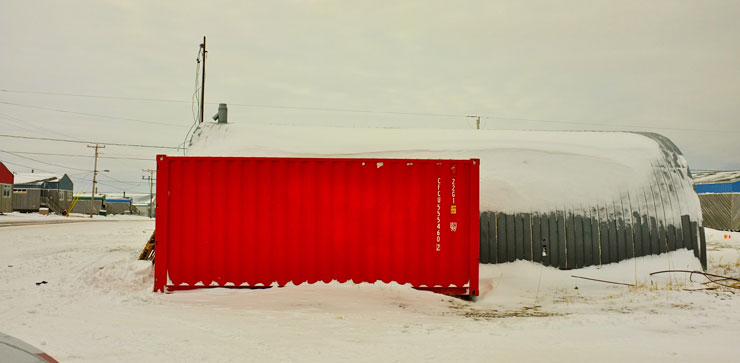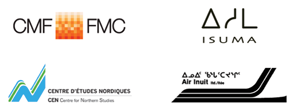About ARTCO

About
Brief
Inuit and Cree children use new media tools through a multidisciplinary artistic process to explore their past and present realities, connect with others, practice collective action and create a better future.
Description
ARTCO is a project led by Kingulliit Productions and IsumaTV that engages children and youth across cultural divisions by using digital media to share experiences, resolve common problems and find new ways to communicate across old barriers towards a better future.
In collaboration with local schools, a series of creative workshops lead by professional guests artists are given to two different groups of schoolchildren and throughout a multidisciplinary artistic process, the children use ARTCO iPods to create multimedia content, upload it wirelessly to the ARTCO website and explore the media that the other children have made. After going through the basics of video making, children are introduce to the Isuma-style video making which employs focused seeing through the camera as a simple ‘no fault’ way to discover meaning and empathy and to make better videos with minimal training.
ARTCO uses a horizontal process which is designed to evolve. Workshop artists are not teachers but rather a different type of ARTCO participant. They are invited to explore different ways of sharing their artistic practice, to learn from the other disciplines by going through the ARTCO experience themselves and, to work together to mix their different art forms in a meaningful way for the children.
Throughout the project children, local teachers, workshop artists and community organizers explore the power, the benefit and the creative energy of collective action.
The ARTCO project gives children a very pleasurable experience with creativity and makes evident to them that the work of art we make impacts social environments in which we live and is a practical tool to lead collective action.
As an action strategy ARTCO collects past knowledge and experience in a public space where people can learn from it. ARTCO uses new media tools to adapt to cultural historic strengths such as communication and consensus decision making, to new practical problems never imagined before, eg. mining, global warming, and language loss; and use the globalized and collective power of the internet to create a better future.
ARTCO as a digital media project for Inuit Cree Reconciliation
In 2011, following the Peace Celebration Event held at Nastapoka River in Northern Québec by a small group of Inuit and Cree, Zacharias Kunuk (Inuit) and Neil Diamond (Cree) - two of Canada’s most respected filmmakers – interview Inuit and Cree Elders in the side-by-side communities of Kuujjuarapik and Whapmagootsui researching an old war story from the 1770’s and its impact on people today for their documentary film Inuit Cree Reconciliation.
Designes as a parallel digital media project to the film lead, ARTCO encourages Inuit and Cree children to investigate the current relationship between both cultures, and - as a healing process - start creating new possibilities for their shared future. ARTCO teaches children to use digital interactive media to express their concerns and dreams, to explore their daily reality and cultural history, and build bridges across national and cultural barriers. Bringing ARTCO to Great Whale River in 2011-12, while Kunuk and Diamond are researching the past, gives children in both communities the chance to join in this process, and express their ideas.
By using video and new media technologies and by going through a collective multidisciplinary artistic process, the children can see what other people think and feel. This allows them to experience their community though someone else's eyes and enables them to practice looking for empathy. As a participatory experience, ARTCO teaches Inuit and Cree children how to create and how to share important parts of themselves in order to enlarge their empathic capacity: within their own community and with other cultures (by creating and interacting with the other’s content)
ARTCO explores daily life as an expression of cultural values, an approach easier for children to follow when working with delicate subjects like historical violence and conflict resolution.
The process of creation enables children to engage in their communities – history, reality, family – to understand themselves in the present and to imagine new possibilities for the future. Between two conflicting cultures ARTCO enables Inuit and Cree children to connect to others who are like themselves and to discover, share and learn from common experiences and interests.
About Kuujjuarapik – Whapmagoostui
Great Whale River is the northernmost Cree village in Quebec and the southernmost Inuit village in Quebec. Located at the mouth of the Great Whale River on the coast of Hudson Bay in Nunavik, Quebec, Canada. The community is inhabited by approximately 500 Inuit people and 800 Cree people and it’s only accessible by air and, in late summer, by boat.
The community has four names Kuujjuarapik (small great river in Inuktitut), Whapmagoostui (place of the beluga in Cree), Poste-de-la-Baleine in French, and Great Whale River in English.
Although the permanent cohabitation of Inuit and Cree at the mouth of the Great Whale River only goes back to the year 1950s, the two nations have been side by side in this area for a very long time; Inuit living on the coast and the Cree inhabitating the interior lands. Members of both Inuit and Cree communities – share Kuujjuarapik-Whapmagoostui though physically and politically divided into two distinct villages.
Like in many other communities in Northern Canada, some of the difficulties children face in Kuujjuarapik – Whapmagoostui are a high suicide rate, alcoholism, drug abuse, anxiety, depression, negligence from parents, sexual and physical abuse, poverty, malnutrition, illiteracy and violence.
Average temperature is maximum +15c and minimum -27c. Because of the community's isolation, goods, including food, are mostly shipped by air. As in the rest of Northern Canada the community has one of the slowest and most expense internet connections in Canada.
The majority of the teachers working in the North are originally from other regions in Canada or the world, as far as Nigeria or Poland. Because they are not from the community, the majority of them stay only one or two years to teach.
Developing ARTCO in this community meant flying in all the artists and materials, installing two satellite dishes with an internet connection devoted to the project and with Wi-Fi access so that children could upload directly from their iPods from anywhere in and around the school. Because uploading and viewing media on the internet in this part of the world is so slow and difficult, ARTCO installed two IsumaTV local servers to be able to upload and view videos at high speed.
RSS Feed:
×




